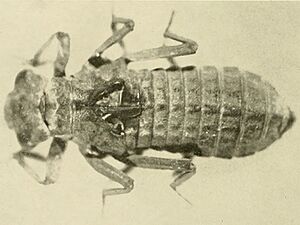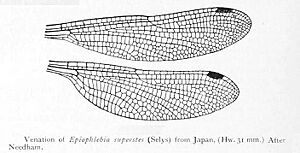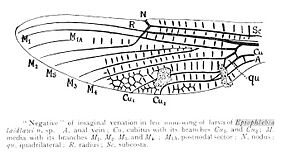Himalayan relict dragonfly facts for kids
Quick facts for kids Himalayan relict dragonfly |
|
|---|---|
 |
|
| Naiad | |
| Conservation status | |
| Scientific classification | |
| Genus: |
Epiophlebia
|
| Species: |
laidlawi
|
The Himalayan relict dragonfly, also known as Epiophlebia laidlawi, is a very special type of dragonfly. It is one of only four species in its family, called Epiophlebiidae. For a long time, scientists thought this dragonfly was a mix between true dragonflies and damselflies. This was because its front and back wings look very similar. Also, it rests with its wings folded back over its body, just like a damselfly.
However, we now know that these features can be misleading. This dragonfly is actually more closely related to other dragonflies. It developed its unique traits as the mighty Himalayas were forming.
Contents
Discovering the Himalayan Relict Dragonfly
This unique dragonfly was first found in June 1918. A scientist named Stanley Wells Kemp collected a young dragonfly, called a larva, from a stream. This stream was located near Sonada, close to Darjeeling.
Later, Dr. Frank Fortescue Laidlaw from Devon identified it as an Epiophlebia. He carefully studied the specimen's developing wings. His identification was confirmed by R.J. Tillyard. Tillyard then officially described the species and gave it the name laidlawi to honor Dr. Laidlaw.
Where Do They Live?
The Himalayan relict dragonfly has been found in several places across the Himalayas. These include areas in Nepal, such as Chittrey, Mt. Shivapuri, and the Kathmandu region. They live in streams at high altitudes, from about 6,000 to 11,500 feet (1,800–3,500 meters). This is where they lay their eggs and where their young grow.
In 2015, scientists also found these dragonflies in Bhutan. This showed that their home range is even wider than previously thought. Another similar species, Epiophlebia superstes, lives far away in Japan. Both species look quite alike, with black bodies and bright yellow stripes. These stripes are found on their chest (thorax) and tail (abdomen).
Life Cycle and Larvae
The young dragonflies, called larvae, live in water for a very long time. They can grow for five to six years, which is thought to be the longest time for any dragonfly or damselfly. Some may even take up to nine years to become adults!
When disturbed, these larvae can make a scratching sound. This is called stridulation. The larvae look similar to those of other dragonflies. However, they cannot use a special "jet-propulsion" method to escape quickly. Instead, they have to walk to move away from danger.
Adult Dragonflies
Adult Himalayan relict dragonflies fly slowly. Their flight can seem a bit clumsy or uncoordinated. They usually fly at very high altitudes, between 3,000 and 3,650 meters (about 9,800 to 12,000 feet). Because they live so high up, they have very few animals that hunt them.
Scientists once thought they bred only in waterfalls at lower altitudes. However, breeding sites have since been found in streams at lower elevations, around 1,800 meters (about 6,000 feet).
Reproduction
When mating, the male dragonfly holds the female behind her head. This is similar to how other dragonflies mate.
After mating, the female lays her eggs by herself. She does not have the male with her. She lays her eggs inside plant tissue. She sits on the stem of a plant that grows near the water. The eggs are laid in a neat zig-zag pattern, from the bottom of the stem to the top. They often choose mosses or similar plants for laying their eggs.
Images for kids







